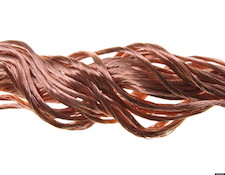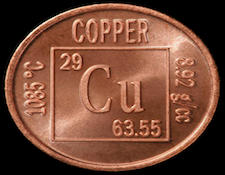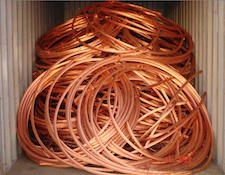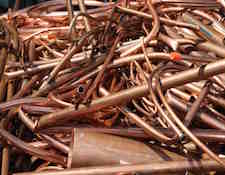It’s the time of year for saving money!
In the last installments of this series about some of the exotic materials (and other technologies) that are used in making our High-End audio toys and goodies, I wrote about (among other things) the metal that manufacturers use for everything from the chassis of our electronic components, to decorative or protective parts (speaker and tube grills, for example, and the shells for our cables’ connectors), to the actual conductors for all of their circuitry (whether using printed circuit boards or point-to-point wiring) and all of the cables used to hook the various components together. The characteristics of metal that I described mostly ignored appearance issues or structural characteristics and even its ability to conduct and radiate heat (as for the cooling fins of a fan-less air-cooled amplifier, for example), and concentrated instead on what I see to be its two most important characteristics for electronics applications: its electrical conductivity or resistance (the reciprocal of conductivity) and its ability to take and hold a magnetic charge.
 The use of different metals, at least for conductors, is, I said, believed by many audiophiles (including me) to create real and clearly audible sonic differences between products. But how can it do that, I asked? And, given that at least thirteen different alloys are used just for the manufacture of audio connectors, what is it about those metals that makes the difference?
The use of different metals, at least for conductors, is, I said, believed by many audiophiles (including me) to create real and clearly audible sonic differences between products. But how can it do that, I asked? And, given that at least thirteen different alloys are used just for the manufacture of audio connectors, what is it about those metals that makes the difference?
It CAN’T just be the conductivity or resistance of the metal, I wrote, because one can make substantial changes to the total resistance available, just by changing the length or thickness of the conductor and, other than a loss of signal level if the change is great enough, there will be no great change to the overall “sound” of the product or system in question. Changing the metal, itself, though, can, as I illustrated with an anecdote involving conductor lengths of just 2 inches (5cm), make a significant change to the sound – even of a very fine product, even as experienced by two recognized industry experts.
 The two most commonly given (and most consistently attacked) reasons for this are, I wrote, crystal distortion in the process of rolling or drawing the wires from which conductors are made and the presence of “micro-diodes” of copper oxide (either Copper (I) oxide “cuprous oxide”, Cu2O ] and/or Copper(II) oxide “cupric oxide”, CuO both of which are known to be semi-conductive when present as thin films between the crystals of the (copper or copper alloy) conductors. A third, related but not often mentioned possibility, is that , Copper (I) oxide is also known to be diamagnetic: In the presence of a magnetic field, such as is formed around any conductor when an electric current is passed through it, it takes on a magnetic polarity OPPOSITE that of the field energizing it. That’s something else that could act to modify or partially cancel signal flow and could, just in itself, affect the “sound” of a conductor.
The two most commonly given (and most consistently attacked) reasons for this are, I wrote, crystal distortion in the process of rolling or drawing the wires from which conductors are made and the presence of “micro-diodes” of copper oxide (either Copper (I) oxide “cuprous oxide”, Cu2O ] and/or Copper(II) oxide “cupric oxide”, CuO both of which are known to be semi-conductive when present as thin films between the crystals of the (copper or copper alloy) conductors. A third, related but not often mentioned possibility, is that , Copper (I) oxide is also known to be diamagnetic: In the presence of a magnetic field, such as is formed around any conductor when an electric current is passed through it, it takes on a magnetic polarity OPPOSITE that of the field energizing it. That’s something else that could act to modify or partially cancel signal flow and could, just in itself, affect the “sound” of a conductor.
I’ll go more into that later, as part of the issue of the effect of magnetism on metals and signal flow, but the more significant thing for now (especially given the purpose of this series of articles to look into which, if any, of the exotic materials and other things brought to the High End as improvements” are actually worthwhile) is the purity of the metals that are used, and how it happens.
 If you’ve ever read a cable ad, you’ve certainly seen references to “oxygen-free” copper or to copper or silver of some number of “nines” of purity. (Also stated as “N”s, as in 5N, 6N, or even more). The nines they’re referring to are the ones describing the purity of the metal in question: Metal that’s 0.9999 pure, for example, or 99.99% pure, is described as “Four Nines” or “4N” pure. As of this time, I’ve heard claims (always by cable manufacturers, incidentally, NOT recognized copper producers or refiners) of copper as much as TEN nines (99.99999999%) pure, but at least three questions always arise whenever people tell me such things: The first of those is “How do you know?”.
If you’ve ever read a cable ad, you’ve certainly seen references to “oxygen-free” copper or to copper or silver of some number of “nines” of purity. (Also stated as “N”s, as in 5N, 6N, or even more). The nines they’re referring to are the ones describing the purity of the metal in question: Metal that’s 0.9999 pure, for example, or 99.99% pure, is described as “Four Nines” or “4N” pure. As of this time, I’ve heard claims (always by cable manufacturers, incidentally, NOT recognized copper producers or refiners) of copper as much as TEN nines (99.99999999%) pure, but at least three questions always arise whenever people tell me such things: The first of those is “How do you know?”.
When I first started XLO, more than twenty-five years ago, I wanted the very purest copper I could get for my cables and, after much searching, finally fopund two sources, both in Japan, for copper claiming to be 6N (99.99997%) pure. On ordering and receiving samples, I – not wanting to be cheated on a purchase that, at that time, rivaled silver for expense – tried to get independent verification of purity from a U.S. testing laboratory, and found that none – NOT ONE – not even the labs at a number of university departments of metallurgy that I contacted, or even the appropriate departments at Anaconda and Phelps-Dodge, two very major U.S. copper producers, had the ability to prove more than four nines of purity, and most were hesitant to go beyond three!
 In the end, I relied on the reputation of the supplier and bought the ultra-pure copper even without independent verification, and was glad that I did, simply because in -one-to-one direct listening comparison, the 6N copper DID sound better. But here’s the second question: WHY did it sound better?
In the end, I relied on the reputation of the supplier and bought the ultra-pure copper even without independent verification, and was glad that I did, simply because in -one-to-one direct listening comparison, the 6N copper DID sound better. But here’s the second question: WHY did it sound better?
Interestingly, there may be a single answer to that question that deals with both of the reasons that I mentioned earlier as having been put forth to explain differences in the sonic characteristics of different electrically conductive metals: distortion of the metal’s crystal structure as a result of the process of rolling or drawing it to form the wires that we use to carry signal, and the presence (or absence) of semi-conductive “micro-diodes” at the junctures of the crystals of which the wire is composed (As said before, micro-diodes are typically inclusions of semi-conductive copper oxide in copper-based conductors, but certain oxides of silver may also have semi-conductive characteristics and may serve the same function in conductors made of that metal. Depending on the process by which the conductor material is made, both the crystal distortion and the presence of micro-diodes may be reduced greatly or, in some cases, even almost eliminated.
I’ll go into what that process is, and how and why it works next time
See you then.





